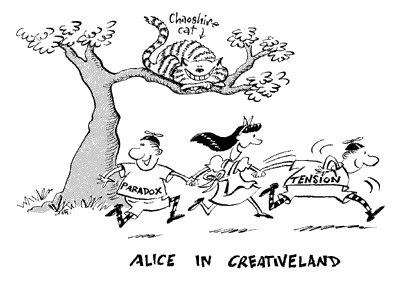
Do not shy away from them as if they were unnatural
Tales
Make it or let it
Unleashing people A complexity tool box
Bibliography
Morgan: Images
Zimmerman: Fractal
Aides
Wicked Questions
Because the behavior of a CAS emerges from the interaction among agents, and because of nonlinear effects, “weird” stuff seems to happen. Of course, it is only weird because we do not yet have a way to understand it.

In a CAS, creativity and
innovation have the best chance to emerge precisely at the point of greatest tension and
apparent irreconcilable differences. Rather than smoothing over these differences –
the typical leadership intuition from the machine and military metaphors – we should
focus on them and seek a new way forward.
"The chaos manager must recognize these
‘forks in the road’ and create a context supporting the new line of development
by finding interventions that transcend the paradoxes or make them irrelevant … The
task hinges on finding new understandings or new actions that can reframe the paradox in a
way that unleashes system energies in favor of the new line of development." |
An organization in which
tension and stresses are quickly smoothed over or even denied is one that isn’t
learning or adapting very efficiently. Consider an organization embroiled in internal
conflict over some kind of change, in which one group wants radical change and the other
is holding steadfastly to the status quo. There may be a temptation for leaders to
compromise, try to deliver to both groups, or prematurely stand by one position while
discounting the other. How might you work with paradox and tension in this case? The
approach one leader took was to mix the two warring factions (the “radical
change” people and the “status quo” people) into a single group and give
them the task of finding a “radical way to hold on to the status quo.” This is a
paradox; it makes no sense according to the prevailing mental models.
However, working on it placed
the group at the edge of chaos and increased the likelihood that creative approaches would
emerge. Here are some other paradoxical questions to consider. Can you think of
others that are relevant to your context?
- How can we give direction without giving directives?
- How can we lead by serving?
- How can we maintain authority without having control?
- How can we set direction when we don’t know the future?
- How can we oppose change by accepting it? How can we accept change by opposing it?
- How can a large organization be small? How can a small one be large?
- How can we be both a system and many independent parts?
Another way to uncover paradox
is to ask “wicked questions.” These are questions that have no obvious answers,
but expose our assumptions. For example, in an organization that was trying to build a
more-enabled environment, one leader asked, “Are we really ready to put
responsibility for the work on the shoulders of the people who do the work?” Perhaps
you can sense the discomfort in such a question. But challenging the sacred cows is an
activity that can put you at the edge of chaos, and begin to reveal the hidden
assumptions.
"Clearly leadership has to do with the
sustaining of creative tension in organizations. Creative tension is derived through
strategic imbalance, which occurs when operating at the limits of organizational consensus
or the boundaries of the organization. Innovation takes place on the edges of the
organization where the potential for far-from-equilibrium conditions is optimal." |
Next | Previous | Return to Contents List
All Components of Edgeware
Principles Copyright © 2000, Curt
Lindberg, Complexity Management, VHA Inc. Permission to copy for educational
purposes only. All other rights reserved.